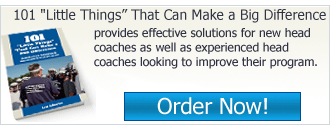You know that the focus of these entries is the “little things” in coaching football. My intention is that little things, if handled correctly, can make a BIG difference in the success of your program! This suggestion may have you scratching your head: but, bear with me! It is this: Wear your whistle to practice. Require your staff to wear a whistle and… blow your whistle!!!
From the early annals of organized warfare, armies have used “horns” as a means of communicating movement of troops. I’ve read of bugles and even drums being used to signal a military movement to advance, halt or even retreat.
When training dogs or birds of prey, handlers use whistles to elicit certain responses in the animal. In a football game, when an official blows a whistle, he is “conveying information” to the players. Most of the time it’s telling them when to stop! Since that is the case, why not use your whistle during practice to “condition” a response in your players?? It’s a training tool that has direct carry-over to the game.
I’ve had good and bad results from the use of my whistle when I was coaching. Let me share:
During the 31 years that I was a head coach, I can’t recall but a (tiny) handful of “late hit” penalties against our players. Why? Because we “trained” our players to react to a whistle during practice. You want to incorporate drills in your position and group work that apply to the game… right? (You should!) So why not “drill” your players every time they’re moving/reacting/performing by hearing a whistle to end the play? I instructed our staff to blow a whistle on every play. Get them used to “stopping on the whistle.”
We often used a “quick whistle” in practice. We wanted to reduce the chance of injury so we blew a “quick whistle” to get defenders to lay off the big hits. This, unfortunately, backfired on me one season! This works fine (quick whistle) when you’re working on your Offense. Not so much when you’re on Defense. Here’s how it backfired on us!
I noticed in games that opposing ball carriers were breaking the first tackle we attempted more than I liked. However, the bad part came after that first tackle was broken… and we had nobody around the ball to finish him off! Lots of “YAC” (yardage after contact) was really hurting us. What was wrong? I studied play after play; watching our kids. It dawned on me: they were “quitting” early! Our pursuit was good. But, when they saw the first hit, everyone geared down. That was when we needed them to speed up! What was causing this?
I looked at our practices. That’s when it came to me! We were blowing a “quick whistle” on our Defense too! The first hit would be made and we would blow our whistles to end the play. We were inadvertently “conditioning” our defenders to gear down when they saw the first hit made in practice!!! Wow! Talk about “carry over” to games… in a negative fashion!!!
We remedied this by setting up our team pursuit drill differently. I placed 4 of those big pop-up dummies around the field. We’d snap the ball, point at a bag and all 11 defenders had 4 seconds to get to the bag. The first guy there tackled the bag. Everybody else “dog piled” on like you see baseball teams do when they win a championship! It added a little fun to the drill but it also taught everyone that they could not slow down until they reached the “ball carrier.” If all 11 did not arrive within 4 seconds, the play didn’t count and they did it again. We’d do 4 rep’s so they had to run to all 4 bags. It also tested them to go as hard on the 4th rep as they did the first! We basically shut down “YAC” gains!
Practices are for preparing your players to perform at their maximum level of ability during games. Using a whistle to end plays has tremendous “transfer of learning” potential. It’s a principle of learning that is critical to success. Apply it to your practices. It makes a BIG difference!

